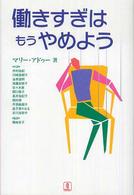Full Description
It was during the Renaissance period that sculptors' models, together with drawings, were first assembled by avid collectors fascinated by the tangible evidence of the creative process of the artist.
This fully illustrated collection of essays, by distinguished scholars and experts in the field, focuses on the process of sculptural design in fifteenth- and sixteenth-century Europe.
The publication arises from a 2017 conference, and is the third and final Robert H. Smith Renaissance Sculpture volume.
Contents
Foreword
Introduction: Designing Sculptures in the Renaissance, Michael Cole and Ana
Debenedetti, with Peta Motture
Acknowledgements
Writing and Drawing: Pages from the Italian Renaissance Sculptor's Studio,
Michael Cole
From Disegno to Design: Typology and Function of Sculptors'
Drawings in Quattrocento Workshop Practice, Ana Debenedetti
Why Didn't Sculptors Draw?, Jim Harris
The Sculptor's Touch: Luca della Robbia and the Clay below the Glaze, Marietta
Cambareri
Achieving Consistency: Drawings, Models and the Transmission of Knowledge in
the Della Robbia Workshop, Rachel E. Boyd
The Creative Process in Renaissance Sculpture: A Reconstruction, Johannes
Myssok
Venetian Fifteenth- and Sixteenth-Century Sculptors' Drawings and Modelli,
Sarah Blake McHam
Metal Appearance and Wooden Substance: Renaissance Sculpture between Model,
Material Experiment and Independent Artwork, Britta Dumpelmann
Baccio Bandinelli's Model for the Tomb of Henry VIII: Context, Function,
Significance, Tommaso Mozzati
Beyond Michelangelo: Artists' Interpretations of his Sculptural Work through
Drawings and Models, Piers Baker-Bates
Drawing from Michelangelo: Raffaello da Montelupo in the Medici Chapel, Ian
Hicks
Giambologna's Sketch-models, Volker Krahn
Contributors and Editors
Bibliography
Index
Picture Credits







